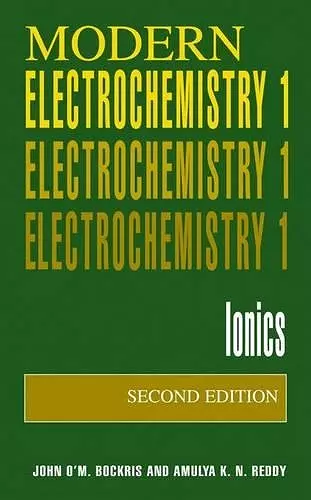Volume 1: Modern Electrochemistry
Ionics
John O'M Bockris author Amulya KN Reddy author John O'M Bockris editor
Format:Paperback
Publisher:Springer Science+Business Media
Published:30th Jun '98
Currently unavailable, and unfortunately no date known when it will be back

Springer Book Archives
Of methods for direct energy conversion, the electrochemical one is the most advanced and seems the most likely to become of considerable practical importance.This book had its nucleus in some lectures given by one of us (J. O’M. B. ) in a course on electrochemistry to students of energy conversion at the University of Pennsyl- nia. It was there that he met a number of people trained in chemistry, physics, biology, metallurgy, and materials science, all of whom wanted to know something about electrochemistry. The concept of writing a book about electrochemistry which could be understood by people with very varied backgrounds was thereby engendered. The lectures were recorded and written up by Dr. Klaus Muller as a 293-page manuscript. At a later stage, A. K. N. R. joined the effort; it was decided to make a fresh start and to write a much more comprehensive text. Of methods for direct energy conversion, the electrochemical one is the most advanced and seems the most likely to become of considerable practical importance. Thus, conversion to electrochemically powered transportation systems appears to be an important step by means of which the difficulties of air pollution and the effects of an increasing concentration in the atmosphere of carbon dioxide may be met. Cor- sion is recognized as having an electrochemical basis. The synthesis of nylon now contains an important electrochemical stage. Some central biological mechanisms have been shown to take place by means of electrochemical reactions. A number of American organizations have recently recommended greatly increased activity in training and research in electrochemistry at universities in the United States.
Praise for the First Edition:
`Superbly written...indispensable.'
JACS
`A truly extraordinary achievement.'
Journal of the Electrochemical Society
`A must.'
Nature
about the Second Edition:
`This excellent teaching book can be warmly recommended to every student of chemistry as well as to all electrochemists in industry and at university. It deserves to be found on the shelf of every electrochemical laboratory.
Journal of Solid State Electrochemistry, 4 (2000)
`... this is an excellent book that outlines basic theories and measurements of ions in solution and ionic liquids. There is no doubt that readers from a variety of research areas will benefit from it. The book is well suited to serve as a reference book or reading material for electrochemistry courses. It should also serve as a very useful and important handbook for electrochemists who are engaged in active research or teaching.'
Journal of the American Chemical Society, 122:9
`The first edition of Modern Electrochemistry, a two-volume set published in 1970, is familiar as a classic work to those who teach and practice electrochemistry. The second edition ... is a worthy successor, containing nearly all the original material, updated with the results of two and one-half decades of additional research, as well as a large amount of new material. ...the authors have done an admirable job of beginning each idea at a very basic level and building from there, the buildup is quite rapid as textbooks go and liberally sprinkled with mathematics and its attendant condensation of information, so the reading is challenging. Additionally, the authors are not bashful about invoking the calculus when it is appropriate. On the basis of the level of treatment and the sheer volume of material, this volume would be most appropriate as a textbook for an advanced course (post physical chemistry) in physical electrochemistry. It seems eminently suitable as a source of supplemental reading for students in a variety of upper-level courses, including physical chemistry. As a reference for the practicing electrochemist it shines because of its thorough coverage of the discipline, its excellent index, and its easy-to-use system of paragraph headings, each of which includes sufficient detail to enable the researcher to confidently identify the relevant portion of text. In view of the challenge presented in reading this text, I (who consider myself an applied analytical chemist) confess significant surprise in finding that the volume is relatively difficult to put down. The authors have managed to include more than their fair share of the "So that's why that happens!" factor.'
Journal of Chemical Education, 76:8 (1999)
`It is an excellent teaching book, indispensable to every student of electrochemistry.'
Corrosion, 58:5
`These original, stimulating and informative volumes offer an unusual approach and inter alia provide an excellent entrée to the field for the non-specialist.'
Emeritus Professor Douglas Inman, Dept. of Materials, ImperialCollege, London
ISBN: 9780306455551
Dimensions: unknown
Weight: 2510g
770 pages
Softcover reprint of the original 2nd ed. 1998